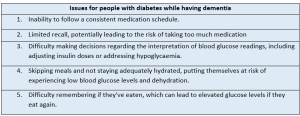For this year’s World Alzheimer’s Day under the theme “Never too early, never too late” IDF Europe highlights the critical need to raise awareness of the challenges of diabetes management in people also living with dementia.
Diabetes is a group of chronic metabolic disorders characterised by elevated levels of blood glucose. It is a highly complex condition, whose onset involves different mechanisms, facilitated by risk factors. Dementia is a term used to describe a group of symptoms affecting memory, thinking, and social abilities and is caused by damage to or loss of nerve cells and their connections in the brain.[1] Alzheimer’s disease accounts for 60-80% of the cases, with the rest split between vascular dementia, dementia with Lewy bodies (abnormal deposits of protein inside nerve cells) and a group of diseases that contribute to frontotemporal dementia (degeneration of the frontal lobe of the brain).
One of the leading risk factors for dementia is ageing. Around two in 100 people between 65 and 69 years old live with dementia. That number also increases with age, roughly doubling every five years. [2] Age is also a factor in diabetes, with 60% of people living with diabetes (PwD) in Europe in the 60-79 age bracket against just 35% in the 40-59 age group. [3]
Diabetes and dementia are intricate, chronic and progressive conditions requiring substantial support for people living with the conditions. As the global population continues to age, the prevalence of these two conditions will also rise.
Diabetes and Dementia: The Connection
Research has consistently shown a link between diabetes and an increased risk of developing dementia (1.5 times for Alzheimer’s disease and 2.5 times for vascular dementia). [4] Diabetes may contribute to dementia in multiple ways. Some of them are connected to the cardiovascular effects of diabetes, which can damage heart health, potentially increasing the risk of strokes and dementia. Another contributing factor may be hypoglycaemic episodes that can impair memory by damaging the hippocampus, further linking these two conditions. [5]
Management of Diabetes with Cognitive Impairment
Diabetes requires robust, round-the-clock management to avoid life-threatening complications. People living with type 1 diabetes and those with type 2 diabetes on insulin therapy must check their blood glucose throughout the day and adapt their treatment accordingly. Going for a walk or a jog, eating an ice-cream or drinking a hot chocolate, breast-feeding a baby – all need to be taken into account when managing diabetes. People with T2D who are not treated with insulin will also need to manage their blood glucose effectively throughout the days and weeks by seeking to eat foods that trigger fast/large hikes in blood sugar in moderation, generally following an appropriate medication strategy and increasing physical activity, which helps lower blood glucose levels.
When diabetes is coupled with dementia, it significantly increases the already intricate challenge of managing this complex condition. [6]

Daily Management
Currently, there is no systematic method for managing diabetes and dementia. In the early stages of dementia, the main approach focuses on self-care strategies and education. While this approach may be suitable during the early stages of dementia, as the condition progresses, the individual’s ability to self-manage diminishes, placing the burden of management on the family and/or caregivers. [7]
Inadequate diabetes self-management can be life-threatening. For this reason, it is of the utmost importance to plan for, and provide clear and easy-to-follow recommendations, to facilitate diabetes management.
For people living with diabetes and dementia, frequent communication and collaboration between healthcare professionals (HCPs) and PwD/families/caregivers is key to anticipate transitions and help people with diabetes and dementia as well as their families cope with new care requirements.
Some studies have also shown that tools such as decision aids[1] are recommended for a patient-centred approach, enabling patient engagement and involvement in the (co) decision-making processes. At the same time, HCPs should take into account the abilities of PwD and their caregivers to follow specific treatment plans and tailor their advice and support for each individual while also maintaining planned regular contact. [8]
Conclusion
Living with diabetes and dementia represents a complex challenge. It requires the dedication of caregivers, specialised healthcare teams and comprehensive healthcare planning at both the individual and system levels. As we celebrate World Alzheimer’s Day 2023, we call for better understanding of, and adequate action to address, the needs of people living with diabetes and dementia, ensuring that they receive the care and support they require to optimise their quality of life and health outcomes.
References:
[1] https://www.who.int/news-room/fact-sheets/detail/dementia
[2] https://www.alzheimers.org.uk/sites/default/files/pdf/factsheet_risk_factors_for_dementia.pdf
[3] https://www.diabetesatlas.org/upload/resources/material/20200302_133351_IDFATLAS9e-final-web.pdf
[4] https://www.ncbi.nlm.nih.gov/pmc/articles/PMC8061228/
[6] https://www.knowdiabetes.org.uk/media/1166/hcp_dementia_trend_final.pdf
[7] https://systematicreviewsjournal.biomedcentral.com/articles/10.1186/s13643-015-0182-4
[8] file:///C:/Users/30698/Downloads/s12916-017-0909-2.pdf
[1] Decision aids may be videos, booklets, or web-based tools that explicitly state the decision, provide information about the decision, and summarize options along with associated benefits and harms. This helps guide the decision maker through clarifying the values they place on the benefits or harms of the options. [9]



